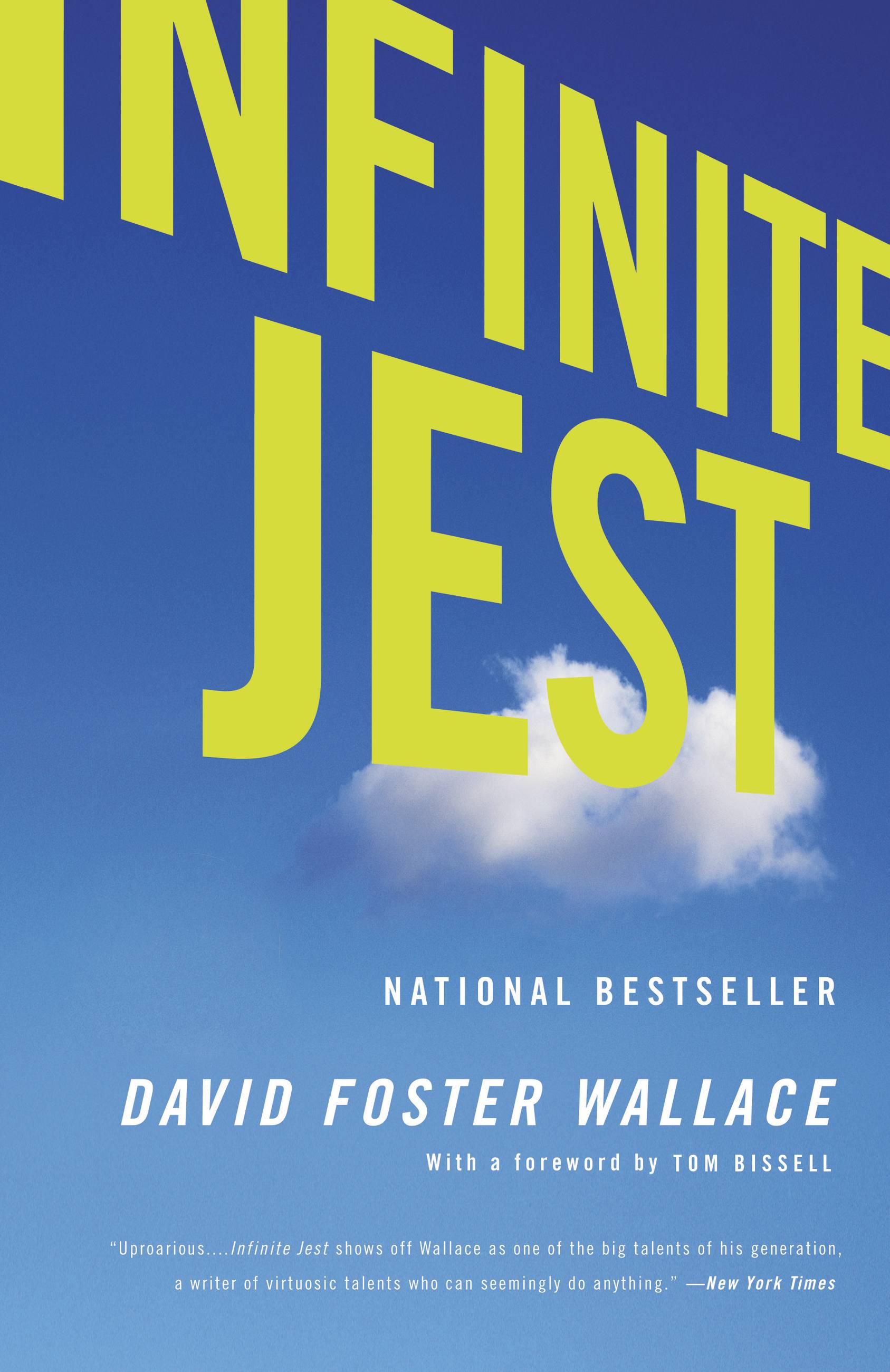Infinite Jest
We are all dying to give our lives away to something, maybe. God or Satan, politics or grammar, topology or philately - the object seemed incidental to this will to give ourselves away, utterly. To games or needles, to some other person. Something pathetic about it. A flight-from in the form of a plunging-into. Flight from exactly what? These rooms, blandly filled with excrement and heat? To what purpose?

In Infinite Jest, David Foster Wallace intertwines a tale following Hal Incandenza, a young tennis protégé living in a Boston prep school, a nearby addict’s halfway house, and a mysterious search for a film cartridge deemed so entertaining that once you start watching, you can never stop. Regarded as DFW’s magnum opus, the novel seeks to uncover the meaning of human struggle while warning us of the dangers of constant entertainment.
The most notable aspect of this book is its length and structure. Spanning over 1,100 pages, it features endnotes that are so lengthy they have endnotes of their own. With one of the central plot points being the game of tennis, DFW bounces the reader between the main story and the endnotes at the back, much like a well-balanced tennis match. As the story comes to a close, it’s important to note that the book doesn’t end in a chronological manner. Only a second read reveals that the narrative picks back up at the beginning, making the book infinite in nature—similar to the entertainment it seeks to explore. DFW positions this work as a meta-modern novel; although it initially presents itself as post-modern, it ultimately transcends conventional boundaries—like those of post-truth—to offer a profound and nuanced commentary on contemporary society. Infinite Jest eerily predicts the rise of figures like Donald Trump through characters such as President Gentle, whose absurdity and fixation on spectacle reflect a society where entertainment and politics merge.
You can get a sense of Wallace’s dark humor and brilliance all throughout the novel, with countless moments that made me audibly laugh. In one scene, a drug addict named Poor Tony hops on the T (Boston’s metro) intending to steal to buy heroin. In this world, artificial body parts are stored externally, and in an unfortunate string of events, Tony picks an old lady’s purse containing a bionic heart keeping her alive as his easy target. After Tony snatches the purse, the elderly woman struggles for her life as her heart stops, screaming, ‘He stole my heart’—which the crowd interprets as a scene of heartbreak and laughs. In another story, a young student named Eric Clipperton vows to become the greatest tennis player—win or die trying. He takes this literally, holding a pistol to his head with one hand as he goes down in sets. With no competitor willing to take Clipperton’s life and a new organization controlling the tennis ranking system, he rises to the top—only to blow his brains out in the end leaving all that he desired. The book is sprinkled with many serious yet hilarious moments, often delivered in a very eye-rolling, ironic, and didactic manner. Wallace himself acknowledged his struggles with irony, calling it, in a 2003 interview, ‘the song of the bird who has come to love its cage.’
With these extreme examples, Wallace points out that our future will be rooted in our obsessions and anxieties. Each story highlights a distinct theme: the nonchalance of death and violence; the modern pursuit of goals that will not fulfill us; the constant distraction of entertainment so embedded that we will still proclaim to be bored. DFW’s predictions feel unsettlingly plausible, questioning the reader’s deepest indulgences.
This brings me to my only complaint about the novel—its length. Many criticize Wallace’s work as pretentious, and it can often seem this way with his expansive command of the English language, flamboyant vocabulary, and overly intricate plotlines. Some of the endnotes are undeniably irritating, and his run-on sentence style can get out of hand. Yet, despite these challenges, these gut-wrenching qualities add to the characters’ relatability. It’s through his unusual -isms that DFW uniquely makes his point of the complexity of the human condition, weaving them into a sensitive and captivating storyline. He captures the human struggle so eloquently that it often feels that he writes from personal experience, while leaving room for empathy toward the flawed characters.
In many ways, Wallace’s novel is a lot scarier than the traditional sort of sci-fi where authors explore the what if. In such novels, writers craft worlds in which something unnatural occurs—what if aliens were on earth? What if animals could talk? What if we evolved into superhuman form in the future? Wallace explores a much more sinister and realistic world—one in which we continue to chase what we desire the most. One where we simply continue the path to seek entertainment, technology that makes us more numb, and where we sell our souls to things that do not matter.
His vision is shockingly grounded—a society over-medicated, drowning in corporate branding, and spiraling into geopolitical absurdity. My main takeaway from Wallace is that growth is uncomfortable. Wallace seems to imply that we must sit in a room and think about difficult things without being rewarded for it. This growth isn’t sexy, yet it is the way revolution moves. You could argue, in a way, that the act of reading the book is just that in itself.
Overall Rating: 10/10
This is my favorite book of all time.
If this book is too intimidating (which it was for me), I recommend Consider the Lobster, a collection of short essays that he wrote as a journalist. It really showcases his sensitive soul, which lead me to embark on this three month challenge.
